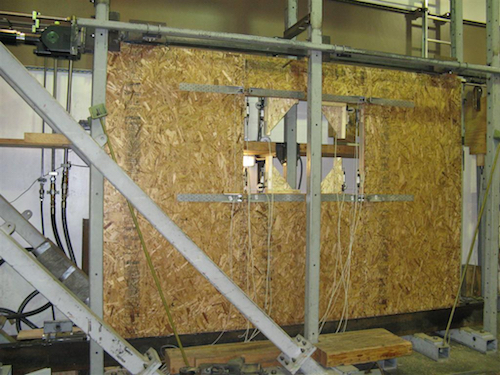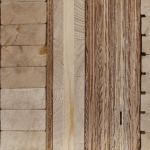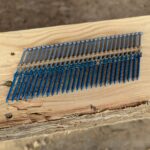Expert Tips
Metal Straps Around Openings in FTAO Wood-Frame Shear Walls
Clarifies a common area of misunderstanding regarding the Force Transfer Around Openings (FTAO) approach to shear wall design.

The American Wood Council’s Special Design Provisions for Wind and Seismic (SDPWS) document provides information and requirements for the design of wood-frame shear walls. Of the three shear wall design methodologies given in the SDPWS, two allow incorporation of openings within the length of the wall—perforated and force transfer around openings (FTAO).
In FTAO shear wall design, higher localized forces occur at the corners of the wall openings. These forces are dissipated into the adjacent sections of shear wall using blocking and metal straps connecting the framing members along the top and bottom of the openings to the wall sheathing on the side sections of the wall. When using this design approach, a common question is whether the straps need to extend the full length of the wall or shorter, isolated lengths of strap can be used.
Part of the confusion associated with this question comes in from this note in SDPWS Section 4.3.5.2(4):
Collectors for shear transfer shall be provided through the full length of the force-transfer shear wall.
Some have interpreted this to mean that the straps need to be continuous for the full length of the wall. This interpretation is further confused by the fact that many published papers and articles show the straps as continuous.
However, SDPWS collector requirements for segmented shear walls, FTAO shear walls and perforated shear walls—in Sections 4.3.5.1(2), 4.3.5.2(4) and 4.3.5.3(5), respectively—are each independently noted and all identical. This suggests that the collectors being referred to are elements such as wall top plates, acting as a continuous collector or drag strut (diaphragm boundary element) collecting diaphragm shears and transferring them into the line of lateral force resistance. The collectors at the top and bottom of openings are not identified as having to comply with SDPWS Section 4.3.5.2(4), nor does that section provide discussion on the purpose of the straps or construction requirements of the collectors.
Although not stated, a common belief is that SDPWS Section 4.3.5.2(4) also applies to the collectors at the top and bottom of openings in FTAO design because these collectors are needed to transfer the discontinuous corner forces into other parts of the wall in accordance with the method of analysis. The collectors (not straps) should run full length of the wall as noted in that section, unless an alternate load path is provided. There is nothing in the code that requires straps to extend across the full length of the wall. If designed and detailed appropriately, the straps need only be long enough to allow for the development of the induced load. SDPWS only requires that collectors be used. It does not define what they should be. The header and sill sections above and below the opening can act as parts of the collector. The steel straps and blocking are used only to dissipate the discontinuous forces into the pier sections completing the full length collector. An alternative load path to full length collectors, such as might be desired when using the FTAO method with openings of different heights, can be accomplished by designing the load path using a transfer diaphragm, allowing partial length collectors. Contact the WoodWorks Help Desk (help@woodworks.org) for an example illustration showing a method that could be used to justify such an analysis approach.



